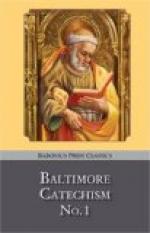The Holy Sacrifice is called Mass probably from the words the priest says at the end when he turns to the people and says, “Ite Missa est”; that is, when he tells them the Holy Sacrifice is over.
264 Q. What is a sacrifice? A. A sacrifice is the offering of an object by a priest to God alone, and the consuming of it to acknowledge that He is the Creator and Lord of all things.
“Sacrifice.” From the very earliest history of man we find people—for example, Abel, Noe, etc.—offering up sacrifice to God; that is, taking something and offering it to God, and then destroying it to show that they believed God to be the Master of life and death, and the Supreme Lord of all things. These offerings were sometimes plants or fruits, but most frequently animals.
When men lost the knowledge of the true God and began to worship idols of wood and stone, they began or continued to offer sacrifice to these false gods. Very often, too, they sacrificed human beings to please, as they imagined, these gods. They believed there was a god for everything—a god for the ocean, a god for thunder, a god for wind, for war, etc.; and when anything happened that frightened or injured the people, they believed that some of these gods were offended, and offered up sacrifice to pacify them. They had a temple in Rome called the Pantheon, or temple of all the gods, and here they kept the idols of all the gods they could think of or know. At Athens, they were afraid of neglecting any god whom they might thus give offense, and so they had an altar for the unknown god. When St. Paul came to preach, he saw this altar to the unknown god, and told them that was the God he came to preach about. (Acts 17). He preached to them the existence of the true God, and showed them that there is only one God and not many gods.
They did not have these idols of wood and stone in their temples for the same reason that we have images in our churches, because they believed that the idols were really gods, and offered sacrifice to them, whereas we know that our images are the works of men. Near the city of Jerusalem there was a great idol named Molech, to which parents offered their infants in sacrifice. We know, too, from the history of this country that the Indians used to send a beautiful young girl in a white canoe over the falls of Niagara every year, as a sacrifice offered to the god of the falls. Even yet human sacrifices are offered up on savage islands. Sometimes certain animals were selected to be heathen gods. The people who worship idols, animals, or other things of that kind as gods are called pagans, idolaters, or heathens.




